Making chili oil at home might seem like a daunting task at first, but once you understand the key steps, it only takes five minutes to make the best-tasting chili oil with extra fragrance, nuttiness and smokiness! {Gluten-Free, Vegan}
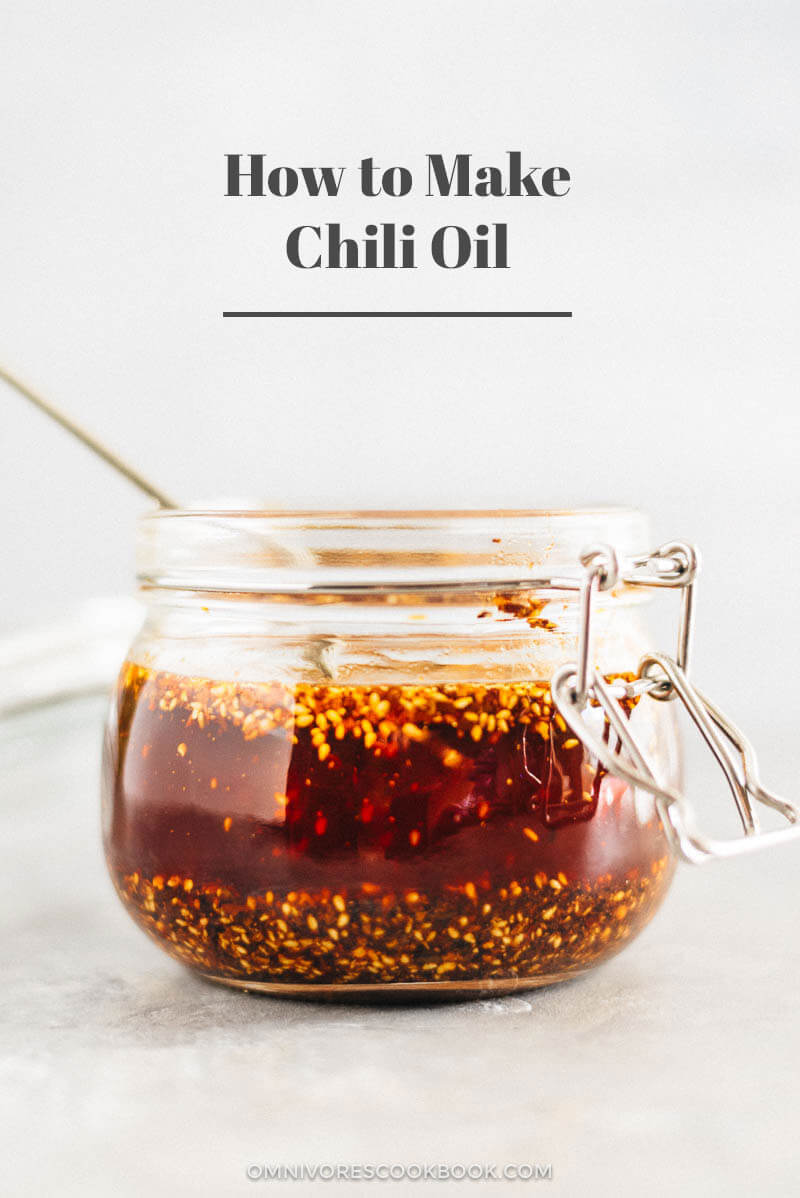
Chili oil is such an important staple for Chinese families, equal to soy sauce and vinegar. For many Chinese people chili oil is as important as ketchup is to American people. It always shows up on tables of small diners, no matter whether it’s a dumplings or noodle place. Once you’re hooked, you’ll want to pour it on everything.
Whenever I’m talking about chili oil, I always refer to homemade chili oil. It tastes ten times better than the store bought product, lasts just as long if you store it in the fridge, and does not contain additives or MSG. There is this fresh aromatic nuttiness that bottled chili oil never delivers.
Plus, when you use chili oil like a Chinese person, you gotta mix in the chili flakes as well. The chili flakes are well toasted when you cook the chili oil, so they taste less spicy but quite smoky with a crispy texture. When mixing with noodles, these tiny umami bits coat the ingredients evenly and each bite releases waves of piquant zing to your taste buds. It’s as exciting as throwing a handful of Pop Rocks in your mouth!
When I cook Vegetable Chow Mein, Lanzhou Beef Noodle soup, and hearty Sesame Noodle Salad, I’ll always spoon a few dollops of chili oil mixed with thick chili flakes onto my finished dish. This one small action will elevate your cooking from mundane to heavenly.
Cooking process
The process might look intimidating at first, but you won’t believe how easy it is once you try it. There are three steps involved.
(1) Combine chili flakes with aromatics of your choice in a heatproof bowl.
A ceramic bowl is my go-to choice. If you plan to use a glass jar, make sure it is heatproof. We will be dealing with hot oil in the next step. Using glassware might cause the glass to shatter and can be very dangerous.

(2) Heat the oil until it reaches 370 degrees F (190 C).
The key to making delicious chili oil is to heat the oil hot enough without overheating it. The hot oil will cook the spices thoroughly and be infused with various flavors. However, if the oil is too hot, it will burn the pepper flakes and sesame seeds, and the resulting chili oil will be bitter in taste.
The best way is to use an instant thermometer to monitor the oil. If you do not have a thermometer, I also introduce a “ginger method” in the recipe below, which is a good indicator of the oil temperature.
Select a small saucepan that has long handle and is good for pouring. Alternatively, you can also use a ladle to transfer the oil.
(3) Pour oil into the bowl with chili flakes.
The oil will bubble fiercely at first and quickly cook the chili flakes. Simply mix everything together with a spoon and let the oil sit until cooled down.
That’s it! Now you have a jar of delicious chili oil to use to create an authentic Chinese flavor.
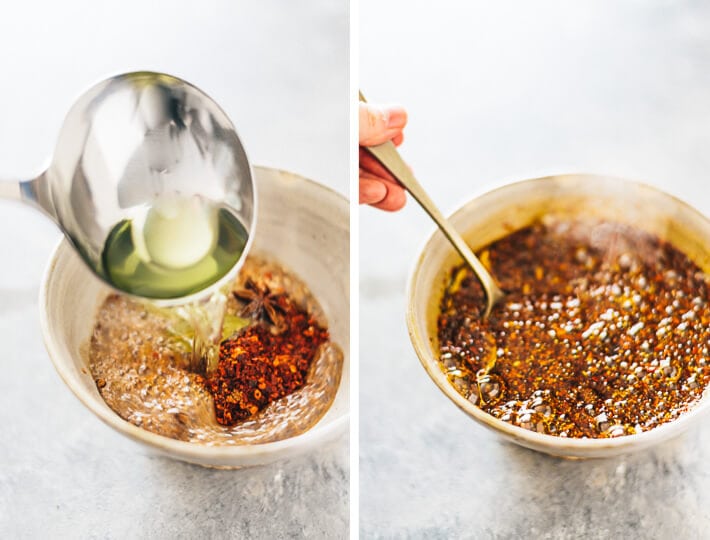
More cooking notes
(1) What types of chili flakes should you use?
The best option is to use fresh chili flakes imported from Sichuan. This type of chili flake is made with premium chili peppers of a vibrant red color. The blend also contains fewer seeds, so your chili oil won’t end up overly spicy.
The next best option is using Korean chili flakes. With these, I found my chili oil doesn’t have the brightest red color, but it doesn’t affect the taste.
(2) How do you make chili flakes?
You can use whole dried chili peppers to make chili flakes too. Lightly toast the peppers in a pan until the pepper turns a bit darker, and grind the peppers into chili flakes. To make sure the oil won’t turn out too spicy, cut open half of the hot peppers with kitchen shears and discard the seeds.
(3) What types of aromatics should you use in the chili oil?
The answer is, you can use many types of aromatics or none at all. The flavor is totally up to personal preference. In China, each region down to each family has their own formula to make their favorite chili oil.
To make the most basic chili oil, you can simply use chili flakes. Some versions use ginger, cinnamon bark, bay leaves, star anise etc.
The recipe below is our family’s formula. We always enjoy adding a few Sichuan peppercorns to add a hint of numbing nuttiness. We also use a pinch of five spice powder to add umami.
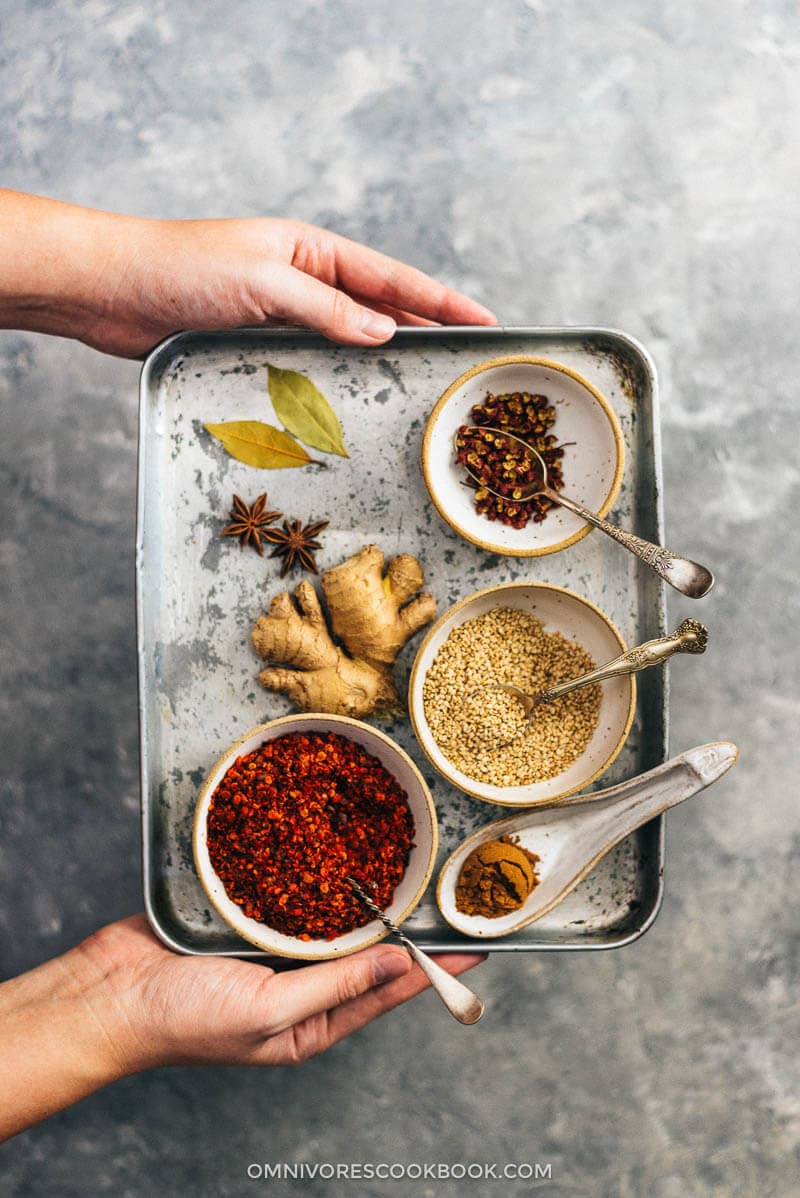
(4) To filter or not to filter the chili flakes?
Once you’ve made the chili oil, you can either filter the oil and discard the chili flakes, or you can leave them in. This habit varies a lot in China depending on the region, so I’d say both methods are authentic and correct.
As a northerner, I grew up having chili oil with tons of chili flakes sitting at the bottom. In fact, in many restaurants you will find the chili oil jar is filled mostly chili flakes and very little oil.
Again, if you choose proper chili flakes (see point #1 above), your chili oil will not be very spicy and it should taste nutty with a balanced umami flavor. The chili flakes should add texture and smokiness to your dish, not spiciness.
How to use chili oil
- Make authentic Sichuan food: Mapo Tofu, Sichuan Spicy Wonton in Red Oil, Sichuan Sliced Beef in Chili Sauce (Fu Qi Fei Pian), Bang Bang Chicken
- Drizzle on soup to make them taste better immediately: Wonton Soup, Instant Pot Chicken Noodle Soup, 15-Minute Curry Ramen with Leftover Ham
- Make a simple cold dish taste irresistible: Real Deal Sesame Noodles, Cucumber Salad
- Use it on congee and oatmeal: 5-Ingredient Savory Oatmeal (Chinese-Style)
- Use it on your roast veggies to add tons of flavor (extremely helpful if you follow a vegetarian or vegan diet)

Other homemade Chinese sauces & condiment
- Chinese BBQ Sauce
- Homemade Sweet Chili Sauce
- Chinese Flavored Sweet Soy Sauce
- Vegetarian Oyster Sauce
- Homemade Black Bean Sauce
If you give this recipe a try, let us know! Leave a comment, rate it (once you’ve tried it), take a picture and tag it @omnivorescookbook on Instagram! I’d love to see what you come up with.

How to Make Chili Oil (辣椒油)
Ingredients
- 4 tablespoons Chinese chili flakes (*footnote 1)
- 2 teaspoons five spice powder
- 3 tablespoons toasted sesame seeds
- 1 teaspoon ground Sichuan peppercorn
- 1 whole star anise (Optional)
- 2 bay leaves
- 1 cup vegetable oil (or grapeseed oil)
- 1 piece thinly sliced ginger (Optional)
Instructions
- Combine chili flakes, five spice powder, sesame seeds, star anise, Sichuan peppercorns, and bay leaves in a heatproof ceramic bowl that can hold at least 2 cups liquid. Place the bowl on a heat resistant coaster.
- Heat oil in a wok (or a skillet) over medium-high heat. Add ginger. When the ginger starts to wither and turns golden brown, immediately turn off the heat. The oil should reach 370 degrees F (190 C) and no higher than 400 F (200 C) if read with an instant thermometer.
- Carefully pour oil or use a ladle to transfer oil into the bowl of mixed spices. The oil will bubble for a few seconds and cook the spices. While the the oil is bubbling, use a metal spoon to stir gently to mix the spices, so they’ll cook thoroughly.
- When the oil cools down a bit, scoop out and discard the star anise and bay leaf.
- The oil is now ready to use! Its flavor will mature if you let it rest for a day, allowing the spices to infuse into the oil.
- The oil can be stored covered at room temperature for two weeks, or up to six months in the fridge in an airtight container.
Notes
Video
Nutrition
The recipe was originally published on August 7, 2014, and updated on April 23, 2017.

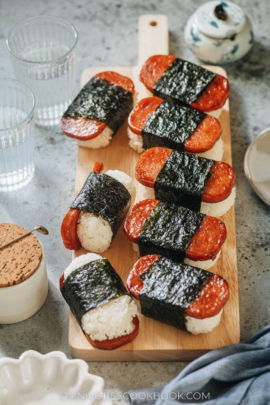
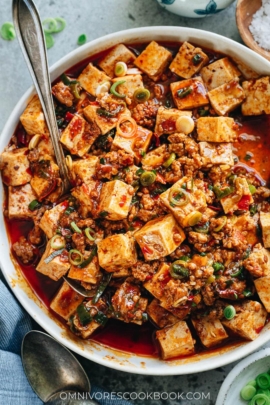

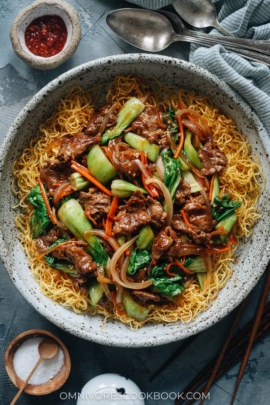
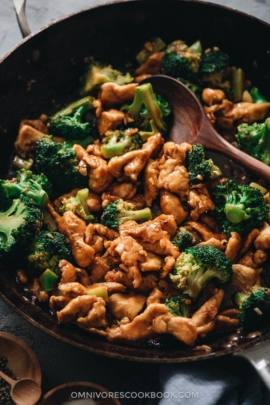
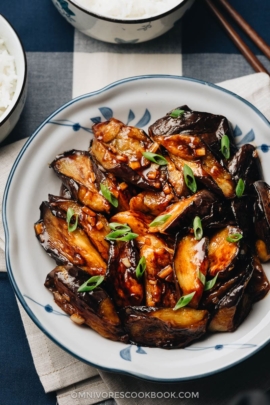






Thank you so much for sharing this Maggie! I really enjoy making my own condiments when I can, I can just imagine how superior this is to the store bought kind. : )
Thanks Crystal! I’m totally agree with you, those homemade condiments have much better flavor. It takes no time after you get used to the cooking process. 🙂
How does it only make 1 cup? There a cup of oil, plus almost 1/2 cup between the chilies, the sesame seeds and the spices? I’m trying to order a jar to store it, and I’m really confused about the total volume of the recipe.
Thank you Maggie. I and My hubby give 2 thumbs up for this chili oil. So fragrant.
Yay for homemade Chili Oil! I’m going to try your recipe next time!
I’m so happy to hear there are people who prefer to cook those things at home. Happy cooking and let me know how it goes! 🙂
This is the best chili oil I’ve ever had!!!
I like how each family seems to make their own version of chile oil 🙂 I add scallions to mine (but fish them out before sealing the jar in the fridge). I love it! I just ran out actually because whenever I’m frying day-old rice or noodles I use lots….. it’s my favorite! Thank you for sharing your version (and good tip about not eating any whole peppercorns :):)
Adding scallion to the chili oil sounds so tasty! I never tried to add chili oil into fried rice, but it sounds great! Thanks for sharing the ideas and I cannot wait to try them out! 🙂
As a music student working on my masters, I shared an apartment with a violinist from Beijing who taught me many such simple recipes. Imagine my horror when I cooked back home and my father tossed the large amount of remaining oil in the garbage! Thanks for the hint on fishing out those lovely green onions for long storage, whose flavor is wonderful in any hot oil.
This has become a staple condiment of mine and I make it about once a month. Nothing compares to the nutty spiciness, and I just can’t get enough.
To get the hot oil just right, I use either vegetable or peanut oil, heat it to 430-440F, and pull it off the burner right as I start to smell a hint of smoke. I suppose other oils will work, but any oil used needs a smoke point above 430F, in order to toast the spices and extract flavor properly without burning.
I found that the ginger test isn’t quite accurate. My ginger slices turned into crispy (and delicious) ginger chips around 400F (I removed them and ate them once they were totally toasted). This may have to do with the fact that an electric stove (which I was using) heats more slowly. The best way to judge the temperature of the oil is to monitor it very closely – with a thermometer or by paying close attention to the faintest hint of smoking oil, or both.
Trying to sign up for newsletter and e-cookbook but it doesn’t go through. What’s up with that?
Hi Deborah, many many thanks for letting me know about this problem. I just realized my newsletter system released an upgrade and I didn’t install it properly. Now the newsletter signup form works properly and you should able to sign up. Could you please try it again? Thank you for your time, and I really appreciate your help 🙂
Thank you so much for this recipe! I tried it side by side with the recipe from Woks of Life and prefer this one, largely because of the sesame seeds which add a nice crunch. The Woks of Life version was very similar, but because it has more Sichuan peppercorn, ended up a bit warmer. I am so addicted to the nutty smoky taste of this chili oil.
Hi Nataline, I’m glad to hear you like the recipe! Adding sesame seeds into the chili oil does boost its flavor a lot, so I personally prefer this way too. Thanks for taking time and leaving a comment to let me know 🙂 Have a great day!
My seasame seeds don’t see to float like yours! And my chili flakes don’t sink! Haha, did I do something wrong?
I can’t believe how awesome the spicy/nuttiness is! Amazing!
I think the chili flakes will sink if you set them aside for a bit longer? The sesame seeds? I have no idea! In fact I’d like them to sink, because they sometimes get in the way lol I think it’s fine as long as it doesn’t affect the taste.
Glad to hear you enjoyed the chili oil 🙂 Use it on noodle salad and it will make the dish awesome.
Did you toast your seeds? I think I read somewhere that if you toasted your seeds they would be more likely to float. Il try to find the article again.
I stumbled on your blog. You make cooking so easy and your short cuts are great. Thanks.
You’re the most welcome CJ! And glad to hear you found my blog helpful! Happy cooking and have a great week ahead 🙂
Hi Maggie! I’m currently visiting Xian and loved Biang Biang noodles so much, I wanted to see a recipe for them and that’s how I found you. Great site and I can’t wait to try your recipes when I get back to the US. We were previously in Chengdu and when we ate dumplings, they always had this red chili condiment on the table to eat with them. It had some floating oil on top, but was more of a chili paste. Is this recipe similar that that, with more oil added?
I just want to take a moment to thank you so much for the recipe of chili oil. This is my new a chapter of my life using your recipes, the best part of all is that you use pictures of the ingredients I want to go to the store I can at least open the phone and show them a picture of what I need and that’s the most important sometimes translation is very hard for me but I just want to thank you!!!! Looking forward to many recipes of yours!
Hi Christine, thanks so much for the kind words and I’m glad to hear my ingredient pictures are helpful! I’ll make sure to take more ingredients photos and add them in my future posts as well 🙂 Yes navigating an Asian market can be frustrating sometimes, even when you understand the language. Last time it took me 15 minutes to locate a small pack of powder for tofu making!
Anyhow, happy cooking and hope you have a great week ahead 🙂
I am glad you brought this post back into the spotlight. Pinning to try and make our own chili sauce soon, we usually purchase it, this looks fun and I can only imagine how much better it tastes.
Thanks so much for sharing Milena! Yes you should definitely make it once at home. It is so easy and the result tastes way better than the bottled chili oil!
Love your site and your recipes. This is a great primer on making chile oil. I know how to make herb infused oils but this is a new take for me. Thanks!
Hi Maggie wich temperature should i pour the oil on the chilies when it reaches 135*celcius or 190*?
Hi Martin, you should wait until the oil reaches 190C. Although sometimes I don’t really measure the temperature, because the air above the pan can get really hot.
What you can do is to pour a small amount into the oil and see if it sizzle. That can be an easier judgement.
Hi Maggie again i’m sorry to ask once again about the same topic here. I forgot to ask aswell if i have to toast the chilies before doing this to make it bring more flavour to the oil or should i skip this? this is my final question i would be very thankful if you could reply once more. Thanks again!
Hi Martin, no worries and please feel free to ask a question anytime!
No you don’t need to toast the chillies flakes because the hot oil will toast it and bring out a lot of flavor.
On the other hand, if you’re making the oil from whole chili pepper, toast the whole peppers can be helpful before you grind them.
Happy cooking and let me know how the chili oil turns out! 🙂
This is completely addictive! The recipe is so simple and straightforward, and the result is just… poetry for the palate. I’ve poured this on everything, from Chinese noodle soups, to roasted potatoes, to salads, cold meats… It really does bring every dish up a notch. Thank you!
that’s the way we are too! It goes on everything. And I just made a new batch …
I just watched your you tube on chili oil! Wow that simple? Am excited to do it now! By the way Maggie I cooked the chicken fried rice last night! So yummy! My husband enjoyed it too! You are amazing! Recipes are simple tasty and very authentic Chinese flavor! And your pretty Maggie! May you continue to be inspired in the kitchen!
There are a few ways to cook chili oil and this is my favorite method, because it is simple and generates great result 🙂
Thanks for leaving a comment and let me know about the fried rice. Glad to hear you guys enjoyed the dish!
Under the photograph, you write “(2) Heat the oil until it reaches 275 degrees F (135 C).”
In the recipe you write, “(2) Heat the oil until it reaches 275 degrees F (135 C).”
Which is it?
Thanks
WHOOPS!!!!
I didn’t notice that my second copy didn’t take before I clicked Post Comment. Sorry about that.
It should read : “In the recipe you write, “The oil should reach 370 degrees F (190 C) and no higher than 400 F (200 C) if read with an instant thermometer.”
Hi Janie, sorry about the confusion! It should be 370 degrees F (190 C). I just updated the blog post so now it’s consistent.
Happy cooking and I hope your chili oil turns out delicious 🙂
Thanks, Maggie!
janie
I thought I was getting the right kind of chile, but now I see not.
I got two different items…dried prickly ash, and ot mieng. Can I use these for my chili oil? (I made some with regular organic chili peppers from whole foods…like you would put on a pizza…and it was very good and smoky, but not spicy at all.)
Thanks for advice. Love everything you post.
Hi Salle, thanks so much for your kind words!
I didn’t see the packages you get, but judging by the names, I think you can use dried pickly ash (aka Sichuan peppers) and ot mieng to make the chili oil. In fact you can use various types of chili peppers to make the oil, which results in different flavors. IF you use the regular chili peppers (smoky but not spicy) again, you can blend in a small portion of cayenne powder or crushed Thai chili peppers (1 to 2 teaspoon per cup of oil) to add spiciness.
I hope your next batch of oil comes out beautifully 🙂
Hi Maggie,
Thanks for sharing such a wonderful recipe. I don’t know how often you make it at home, but I’ve made it 2x in the last two weeks because it is a hit with my family, and the results are amazing and consistent. Thank you!!!
I have been making this frequently, thanks to your easy directions and recipe. I’m hooked! I like to use a mix of regular, organic chili flakes (from the grocery spice section) and ones I got at an Asian grocery store, because that way it isn’t too spicy, just smoky and wonderful. My absolute favorite way to use it is as a simple dunking sauce for roasted squash, carrots and sweet potatoes. Just standing over the counter, being amazed at how delicious it is. And even though I’ve transitioned to a “no meat, no dairy, no eggs” lifestyle, I still get to keep my homemade chile oil. Thank you!
hi. How log does it keep?
Hi Nicole, the chili oil will last very long time if you store it in a jar in the fridge. One jar lasted half a year in my fridge without any problem. Although just like any other homemade sauce, it tastes the best when it’s fresh and it will last for at least 3 months without any problems.
Oh my, I don’t know how could I have lived without it! I simply LOVE this recipe-the taste is so perfectly balanced and totally addictive. Thank you for sharing!
You’re the most welcome! Me too, I have have a big jar in my fridge because it’s such a staple 🙂
Best Chilli Oil recipe to date! I substituted a little sesame oil because I didn’t have sesame seeds on hand and also added a pinch of salt. The other chilli oils I made in the past were boring compare to this. Yours has that layered, deep rich flavour. I’m going to check out the rest of your recipes. Cheers, Vic
Hey Maggie, great recipe! Just tried it out, and I have one quick question. I was unsure about the temperature of my oil. If some of the chili flakes are floating and some rest at the bottom of the container (maybe 50/50 ratio), do you think that means the floating flakes were undercooked? Or is this normal for chili flakes from Mala Market? Thanks!
Hi Greg, sorry for the late reply. To answer your question, once you pour in the oil, some of the chili flakes will be floating on top but most of the chili flakes should sink to the bottom once the oil is cooled down. If half of the flakes are floating, the oil temperature is probably not high enough.
Hello Maggie, I just made it! Yummy even without the Star anise. Thank you for sharing your recipe.
Hi Cheff, How long the hot chilli oil will expired ?
Hi Sue, the chili oil lasts very long in if you store it in an airtight jar in the fridge. Pretty sure some of my old chili oil dates back to 6 months ago (or even longer). They taste the best while fresh, but they last very long and you can use it as long as the oil still smell good.
Made it the aroma was just incredible! Going to try it over CNY?
I’ve made this twice now, and it’s just fantastic! I especially like how you gave the “ginger” method for testing the oil heat. I used it and it worked great. I was originally hesitant about using star anise (because my husband doesn’t like the flavor) but it doesn’t flavor it strongly, more like lending a sweet/smoky richness to it. I’ve even used this oil as an accompaniment to spoon on top of some cheese on a cheese platter 🙂
Hi Sarah, so glad to hear the recipe worked for you and thanks for taking time to leave a comment!
Use chili oil on a cheese platter? That’s a brilliant idea! I’ll try it out the next time. Yum!
Thanks for sharing and have a great day 🙂
I really like the idea of using five-spice powder so I tried your recipe last weekend and it was lovely. I hope you don’t mind too much but I tweaked it a little (sort of hybrid of my usual go-to version) by adding sesame-seed oil after it has cooled for a couple of hours, and byincreasing the Szechuan pepper. I also add a couple of cloves of very finely chopped garlic to the dry chili flaķe mix and it worked well. Thankyou for sharing.
Hi Mark, I’m glad to hear you like the recipe! No worries about tweaking the recipe and I’m happy that you can find cool ways to make the chili oil tastes even better! I love the idea of adding garlic and sesame oil too and sometimes I do that at home 🙂
Thanks for taking time to share your method and hope you have a great day!
Hi Maggie – I have been enjoying your website very much. I hope to make this recipe in combination with your Dan Dan Noodle recipe. I don’t know whether my ceramic or glassware is truly heat-proof. Could I use a small cooking pot instead?
Thanks,
Janet
Hi Janet, a small cooking pot is perfect for making the oil! I often use it myself because I cook the chili oil in big batches.
Happy cooking and hope your chili oil turns out great!
Hi Maggie, can this oil also be stored in the counter? Thanks in advance!
Hi Barbara, yes, you can store the oil at room temperature on your counter. Just to make sure to avoid direct sunlight and use an airtight jar. It stays good for couple weeks.
Great recipe, but use extra virgin peanut oil if you can find it. It takes it to the next level!
I made this chili oil, but I want it to be a bit spicier. What can I do to make it spicier? Add more peppercorns? More chili flakes?
Hi Maggie, the fastest way to add spiciness is to add some cayenne pepper powder to the blend before pouring in the hot oil. Although you need to experiment with the amount, so your oil won’t end up too spicy. If you want to make the existing jar of oil spicier, I would heat up a few tablespoons oil and cook cayenne pepper powder in it. Then blend the super spicy oil into your current jar to bring up the spiciness.
Thank you! I will try that!
Fantastic chili oil recipe; even better in my opinion than Fuchsia Dunlop’s! I love how the rich, earthy spice complements the pepper heat. I used locally-grown santaka pepper flakes.
I’ve already done this wonderfully aromatic oil three times, my whole kitchen smells wonderful!!
I have been using the Korean chili flakes for a very plain, but tasty red oil, going way overboard on the flakes to get a strong pepper ( not hot ) flavor which I found wonderful. Seeing the addition of other spices to the oil opens a new door in the world of flavor. I will try it tonight with fresh homade noodles. Been using pepper flakes, black vinegar and oil marinating in a jar to get a good topping comparable to what I got in Xian, Now that I make my own persimmon vinegar, I look forward to a much more flavorsome experience. ( not that the old version wasn’t excellent )
Hi Maggie, thank you for the great recipes, I’m going to make this one today, which do you prefer, peanut or vegetable oil?
Hi my question can I use corn oil for this recipe or please if I can use oliva oil
Hi Maggie – would you ever make the chili oil using an olive oil or avocado oil instead of a vegetable oil ? Or do you recommend sticking with the grapeseed oil ?
Is it ok to use olive oil for this recipe?
I want to thank you for awakening my memories. Some of your recipes remind me of my Father, who is gone now. I can’t wait to try to make these foods; I have not had them in quite some time.
So good!!! I just finished the oil and am making the wontons and am looking forward to making the beans tomorrow! Such great recipes Maggie Thankyou so much! Very excited to cook over the next few weeks.
I may have overlooked it, but I could not find your recommendation forsichuan chili peppers in your wonderful pantry list. If it is not here please consider adding a referenc to your pantry list. I have purchased may of the items from there and added to MY pantry, and now I can just reach in and make many of your great recipes!!!! I did purchase sichaun chilis from Amazon. They are plump, and not crumbly dry…..I have to chop them with a knife, which is fine!!
I made this exactly from the recipe and it is FANTASTIC. Thankyou. Today from your website I also made sweet chili sauce….too fabulous, using the same chilis!!
Realily straight forward and delish. I look forward to making this.
I am definitely trying my hand at this. I love Chinese chili oil but have only used the jar brands. This will be a treat. I also make an Italian chili oil–a recipe that has been passed down in my family. It even looks the same. What I find interesting is the crossover between Chinese cooking and Italian cooking. Very different flavors with some of the same ingredients. It seems like somewhere along the line there has been some influence between the two cuisines. Lovely website M. I’m making the string bean chicken tonight with a side of Italian pork dumplings (ravioli). Not really…but I do have the string bean chicken on the menu for tonight. LOL Oh, and the wok General Tso’s chicken was yummy and crunchy.
I’ll try your family recipe, nothing in it I don’t love.
Oh my god!!
My kitchen smells so amazing after this. I couldn’t find Korean or Chinese chilli near me so just went ahead with the local variety. Also added star anise and a stick cinnamon. The magic was in the temperature though. Have fallen in love with it. Can’t wait to try it in your sesame noodles.
Thankyou so much for making asian cuisine accessible. Live it. ❤️❤️
This is a wonderful chili oil recipe. This is my first attempt at making this and it came out great. Second attempt I left out one bay leave, and the star anise. Third attempt I left out half the toasted sesame. My forth attempt today I added one extra table spoon of chili, and only one teaspoon of 5 spice. powder.
ITS PERFECT.
I think adjusting to taste is the best way to decide how you like it.
Thanks so very much
Jacqueline
Very easy to make. Not as hot as one would expect given the amount of chili’s. It is however extremely fragrant.
Instead of using a ceramic bowl, I used a 2 cup pyrex measuring cup which worked just fine since the borosilicate glass can easily take the heat. Doesn’t hurt to preheat the glass with not water to lessen the temperature drop.
My FAVORITE chili oil recipe. I can’t go back to store bought. The anise seed pod really kicks the flavor up a notch and adds to the complexity.
The phrase “you can use korean chili flakes” is goodsend to me and I’m sure many others. Thank you!!! My chili oil looks and smells incredible. You are right, no more buying chili oil. Is it alright to add salt and sugar
Hi! I made it and will remake it again 🙂 I used the same ingredients as your recipe and the sauce is really easy to make, full of flavours, and goes with so many dishes, thanks a lot !
Barbara
Hello Maggie,
Have not tried this yet but am excited to get it going. One question before I begin… The peppercorns are purchased whole but the recipe calls for ground peppercorns. Could you explain this a bit more for me please? I’ve experienced these babies before and I really don’t want to add more than required ’cause I feel like that’d be a chili oil disaster for me. I’m eventually using the oil to make your Mapo Tofu.
Thanks!!
Amber
Hi Amber, I usually use my coffee grinder to ground the Sichuan peppercorns. You can use a mortar and pestle as well. If you do not wish to have a strong peppercorn taste in the chili oil, you can simply use the whole peppercorns when pouring the hot oil, then you can fish them out afterwards. j
Cheers! Thank you.
I have several different chili oils but when I made this I was ready to throw the rest out! This is so amazingly good that I use it every day on everything. Make it!
Tried it and loved it. Thank you.
Thank you for sharing this recipe Maggie. I made it for Dan Dan noodles and it was delicious! I used Korean pepper flakes which is just the right amount of heat for me. I would say the star anise is necessary – it’s what makes this chili oil the best I’ve ever had!! And so easy, there’s no reason to buy store bought anymore.
So happy to hear you like the recipe 🙂 I always have a jar in my fridge and I put it on many dishes to boost flavor.
Thank you I love this
Revolutionary. Will be making this for years to come.
Hi – I’ve made once with canola. But would you use caiziyou since I have it? Thanks!
Yes, Caiziyou will totally work!
Thank you Maggie! I had tried to make chili oil following a different recipe elsewhere, and it ended up being a disaster. Following your steps, I was successful this time around. So excited to use this in my cooking! Delicious, fragrant and wonderful!
This recipe turned out great – simple, and really elevates chinese food made at home (or takeout eaten at home:) ) I hope to find some good chinese peanut oil, and make my next batch with that!
Thank you for this excellent recipe Maggie! We made this yesterday to serve with dan dan noodles and it was exactly as you said. We left out the optional ingredients except for the garlic and it was perfect!
370 degrees F is *way* too hot for the oil. I used a thermometer to make sure I got the temp right and the spices and chili flakes burned immediately. Most recipes I’ve looked up use a temp of no more than 250 degrres F.
Hi Maggie,
Chili oil is really good. Tried it in Cucumber Salad, in ramen and in Miso soup, goes well with everything.
Gary
The first time I made this, I thought, I should give some to a friend. How will I go through so much spicy oil before it starts to go bad?
I had to make a new batch three weeks later, because we started putting it on everything! Soups, eggs, meat, fish… it’s great on plain white rice if you’re in the mood for a quick snack. I have to make it every two weeks now. We go through a lot of it.
I put off trying this recipe for such a long time out of…laziness, probably, but I finally made it a couple of weeks ago and I can’t believe it took me so long. I put it on eeeeeeverything, it’s SO delicious!
Hi I was just wondering if could just use red pepper flakes instead because I dint want to buy Chinese chili flakes and Sichuan pepper corns. Which is more important?
It’s totally OK to replace the Chinese chili flakes with red pepper flakes as long as your blend is not super spicy. Chinese chili flakes are usually medium spicy so the chili oil will end up fragrant but not too hot.
The Sichuan peppercorns is not spicy at all, but has a numbing tingling taste when chew on it. It will add a different dimension of aroma to the oil, so it’s not replaceable by other spices. That being said, you can always skip it (many chili oil brands do not include it I think), but I really like its taste.
This is a great recipe, thank you! How would I go about making this spicier? My family loves it however adding more chili flakes did not make it spicier as I would have expected. Is there another ingredient I can add to increase the heat? Thanks.
You should use a different type of chili such as a bit cayenne powder if you want to increase the heat.
This is a great recipe. It’s very easy, just takes a bit of time to gather the various components beforehand. We used to buy chili oil in China but since we’ve gone to NZ, it’s hard to find good oil without preservative. Now I make this and it’s great with our noodle soup.
Hello, this is a great recipe! I was wondering I just have canola oil. Would this work?
Yes canola oil will work. Happy cooking!
A very fine recipe. We always have some in the fridge and make some fresh monthly. We use very good quality canola oil and are exact about the temperature.
I just discovered your site and I love it. Thanks. I have a cooking chili oil problem. Would it be possible to place the ingredients in a pot with the oil and cook at 225? I’m not comfortable with cooking with oil at 375 or 400. I can remove the bay leaves and star anise after it cools. Thanks
I have another recipe that cooks the oil in the pan: https://omnivorescookbook.com/biang-biang-noodles
The formula is different but the result is great.
I’ve made this chili oil a couple times in the past week and I absolutely love it. Unfortunately, I did not use Sichuan seeds since I don’t have it in on hand, but the result still has the nutty, smoky taste that I crave! I can’t wait to try this recipe with real Sichuan peppers. I also used avocado oil and black sesame seeds, since that’s what I had on hand.
I find this recipe more approachable than some recipes since it calls for using a five spice mix. As a result, I was able to try making chili oil at home for the first time and it was so worth it! Thank you for sharing.
This is a wonderful and easy recipe. I make extra for family members, who love it.
This oil is a hit with everyone. It is so much better than the old stuff on the tables in restaurants it stuns people when they try it!
I can’t wait to try this recipe for chili oil. Unfortunately, I think the ground chili’s you recommend at Mala Market would be too spicy for me (do you know what number on the Scoville scale these might be?) The description says it’s a mixture of mild, moderate, and hot flakes but this link https://themalamarket.com/collections/all/products/er-jing-tiao-chili is more mild so I may try that first.. your thoughts?
I think you can totally buy milder peppers and ground them to make your own blend. The Er jing tiao chili would be nice since it’s milder.
PS. the chili pepper flake blend from the mala market is actually not that spicy if you make them into chili oil. It does contain some hot pepper flakes but I never found it overwhelmingly spicy. Of course you can make your own blend just to be safe 🙂
Thanks Maggie. I made the oil with some Korean chili flakes I had on hand and it wasn’t too spicy but I did purchase the ones you recommended from the Mala Market. I also bought their Sichuan peppercorns and will make the chili oil again when this batch is gone. 😍
Hi I think my oil wasn’t hot enough as when I poured it the chilli flakes didn’t foam… have I ruined my chilli oil?
Hi Tania, the oil has to be hot enough to release the flavor from the chili flakes. What you can do is to return everything into a small sauce pan, heat over medium low heat while whisking to slowly bring the oil to a simmer. Use very gentle low heat to cook it for 3 to 4 minutes, until the chili flakes just turn slightly darker and the oil is orange / red. Then you can let it chill completely before using it.
I love this recipe! Simple and easy to follow.
Mmmmmm. Yeah. That’s good! Thank you!
Amazing! I find myself adding it to everything. My parents gifted a load of chilis, which I dried and used whole out of sheer laziness. Just perfect.
I’m confused about the chili flakes. Maybe I’m just ignorant of the available varieties of chili flakes. I think I’m also hampered by living in Japan. The only chili flakes I’ve seen are simply called red chili flakes without any indication of the type of chili in the bottle. Can you direct me to a Japanese source, or a site where I can get more info? I don’t know what to buy for this essential ingredient. Thank you. I’m a much better cook because of you.
Hi Barbara, the chili flake is a blend of ground up chili peppers that have different hot levels.
The ground is coarse than the chili powder, but it’s OK to use the find ground as well.
The product from the Mala Market is the best: https://themalamarket.com/products/sichuan-chili-flakes-xiang-la-jiao-mian?aff=2 (Not sure if they’re offering international shipping right now but it’s a great resource to learn about the product)
The chili pepper you showed in the other comment is one of the chilis that’s used in this blend. If that’s the only dried chili pepper you can find, you can use a food processor or blender to grind it, then use the grind as the chili flakes. The only tricky part is to decide how much seeds you want to include, because the seeds are the most spicy. If not sure, I recommend removing half or most of the seeds, so the oil won’t get too spicy.
Thanks! I needed a little reassurance on this point.
I’m having a difficult time finding the chili flakes necessary to this reecipe. I think I’ve found something on Amazon.co.jp — Sichuan Chili Pepper Chaotian Chili Pepper Chili Hall Chili Pepper. Link: https://www.amazon.co.jp/-/en/gp/product/B08BWZS34H/ Is this a reasonable substitute?
Success! I purchased the chili flakes as discussed. By this time, the oil had been made. I used a very fine sieve to separate the solids from the oil, but I was concerned about heating it to temp again. So I heated up a scant cup of new oil and once it was at temp, added the flavored oil. It was much easier to bring it up to temp and pour it over the chili flakes, let them fry then add back the other ingredients. The oil developed a beautiful mahogany red color and tasted incredibly delicious. I tested it on some homemade beef curry with amazing results. The chili oil enhanced the entire dish and provided a bit of a kick. Not super spicy, but it made a powerful impact on the overall flavor. Bonus: I’m totally going to find out more about chilies and will never turn to store-bought chili oil again! Thank you so much, Maggie, for the recipe and for your personal guidance. I’ll post some photos on your IG feed.
Was easy to make, and tastes amazing. Be sure you use ALL the aromatics – especially the Sichuan Peppercorns.
My first time making homemade chili oil and your right it’s way better than store brought. Thank you! Does this chili oil need to be refrigerated?
So happy to hear you like this one! If you plan to use the oil very fast, like in a week or two, then you can store it at a cool dark area in the kitchen.
But to keep the maximum freshness, I recommend to always store it in the fridge.
How long will Chilli oil last ?
It last quite long if stored in the fridge sealed, but the flavor will slowly diminish. The oil will probably last a year without any issue, but I think you will get less fragrance from it after 6 months.
Thank you for this recipe! Your right homemade chili oil is much better. Does this chili oil need to be refrigerated?
Yes, you should refrigerate it so it stays fresh longer (unless you plan to use it within a few days). In the fridge it lasts pretty well for a few months. And then it will start to lose fragrance but will stay good.
Absolutely the most delicious chili oil I’ve ever had. Even better than Lao Gan Ma, for sure, and surprisingly easy to make! I’ve made the chili oil using this exact recipe at least 3 or 4 times by now (my boyfriend and I just eat it all up!), and I love adding it to pretty much any Chinese or Asian-style dish that I make!
So happy to hear you like this one and thanks so much for leaving a positive review 🙂
Hi Maggie, I’m very excited to make this chilli oil and plan to include all the aromatics, so I’m wondering if fresh or dried bay leaves are best? I have some fresh ones in my garden but have dried some out too, if that works better for this recipe? Thanks!
You can totally use the fresh one. I would use 1 instead of 2, since the fresh one is more fragrant. Happy cooking!
Bonjour Maggie thank you for sharing your passion with us. Please is the Chili oil in the new cook book.
Made this last night and waited a full day to taste. Just delicious! I really love the ginger method, so I don’t have to fuss with a thermometer. Now I’m off to make your Dan Dan noodles. Cheers!
Happy to hear you like the recipe and thank you for leaving a positive review!
Happy cooking and let me know how the Dan dan noodle goes 🙂
i’ve been a quiet user of your recipes for quite some time. not sure what possessed me to finally being reviewing but you deserve it!
this chilli oil was so pleasently fragrant! thank you.
I have a question about making chilli oil, what if I burnt the spices in the oil and the oil tastes bitter what can I do to salvage it?
Store bought is garbage compared to this recipe… after a day it’s has really good flavor!
I made this so I can make your steamed eggs with pork. It was extremely easy. I used two Le Creuset saucepans with spouts–one to heat the oil and the other for the spices. It’s really good, but I’m wondering why it is neither salty or sweet like some other chili oils I have bought like Xian’s Famous Foods brand. It’s pretty neutral other than the spices.